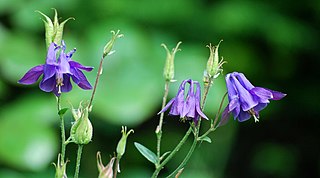
Aquilegia is a genus of about 130 species of perennial plants that are found in meadows, woodlands, and at higher elevations throughout the Northern Hemisphere, known for the spurred petals of their flowers.
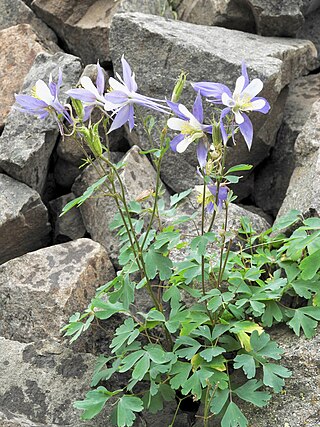
Aquilegia coerulea, the Colorado columbine, Rocky Mountain columbine, or blue columbine, is a species of flowering plant in the buttercup family Ranunculaceae, native to the Rocky Mountains and some of the surrounding states of the western United States. It is the state flower of Colorado. The Latin specific name coerulea means "sky blue".
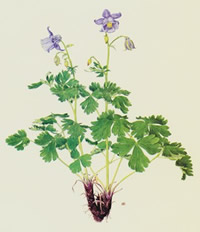
Aquilegia nuragica, commonly called Nuragica columbine, is a perennial flowering plant in the family Ranunculaceae. It is endemic to Italy, in a single canyon in the Supramonte mountain range on the island of Sardinia.
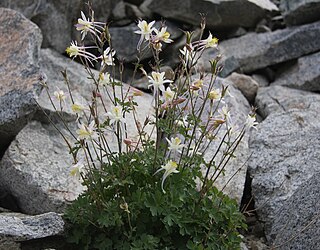
Aquilegia pubescens is a perennial flowering plant in the family Ranunculaceae, endemic to the Sierra Nevada in California. It is usually known by the common name Sierra columbine, and less frequently as the alpine columbine or Coville's columbine.

Aquilegia eximia, the serpentine columbine or Van Houtte's columbine, is a perennial species of flowering plant in the family Ranunculaceae, endemic to California.
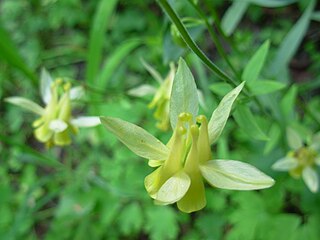
Aquilegia flavescens, the yellow columbine, is a perennial species of flowering plant in the family Ranunculaceae, native to the Rocky Mountains of the United States and Canada.
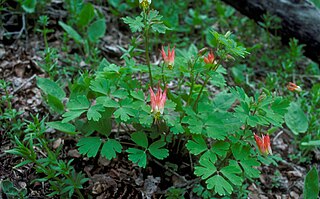
Aquilegia elegantula, the western red columbine, is a perennial species of flowering plant in the family Ranunculaceae, native to the Southwestern United States and northern Mexico.

Aquilegia longissima, the long-spur columbine or long-spurred columbine, is a rare perennial flowering plant in the family Ranunculaceae that is native to northern Mexico, Texas, and Arizona.

Aquilegia fragrans, the fragrant columbine or sweet-scented columbine, is a perennial species of flowering plant in the family Ranunculaceae, native to the Western Himalayas.

Aquilegia viridiflora, commonly known as the green columbine or green-flowered columbine, is a perennial flowering plant in the family Ranunculaceae, native to southern Siberia, northern China, Mongolia, and Japan.

Aquilegia barnebyi, commonly known as the oil shale columbine or Barneby's columbine, is a perennial species of flowering plant in the buttercup family, with a native range comprising northeastern Utah and northwestern Colorado in the United States. It is named after Rupert Charles Barneby, who, with Harry Dwight Dillon Ripley, first discovered it in Colorado.

Aquilegia ecalcarata, the spurless columbine or false columbine, is a perennial species of flowering plant in the family Ranunculaceae, native to central China.

Aquilegia parviflora is a species of flowering plant of the Aquilegia (columbine) genus in the family Ranunculaceae native to the Asian regions of Siberia, northern Mongolia, northern China, and Sakhalin.

Aquilegia sibirica, the Siberian columbine, is a species of flowering plant in the family Ranunculaceae native to the north-central Asian regions of Siberia, northern Mongolia, Kazakhstan, and Xinjiang. A hardy perennial plant, it prefers temperate environments. The Siberian columbine can be between 1 foot (0.30 m) and 2 feet (0.61 m) tall with flowers that are lilac-blue and white in color.
Aquilegia atrovinosa is a perennial species of flowering plant in the family Ranunculaceae native to Central Asia.

Aquilegia bernardii, common name Bernard's columbine, is a perennial species of flowering plant in the family Ranunculaceae, endemic to Corsica.

Aquilegia buergeriana is a perennial species of flowering plant in the family Ranunculaceae, native to Japan.

Aquilegia amurensis is a partially accepted species of flowering plant in the genus Aquilegia (columbines) in the family Ranunculaceae that is native to the northeastern Asian. Its natural range is in the northern Greater Khingan mountain range and Amur River of China, as well as Siberian Russia, Mongolia, and possibly North Korea. Flowers of this plant have petal blades that are whitish or white-tipped, with blue-violet nectar spurs and sepals. The plant is rarely cultivated.

Aquilegia dumeticola is a perennial flowering plant in the family Ranunculaceae, native to southeastern Europe.
Aquilegia × emodi is a perennial flowering plant in the family Ranunculaceae, native to the Western Himalayas. It is a natural hybrid of Aquilegia bashahrica and Aquilegia pubiflora.


















